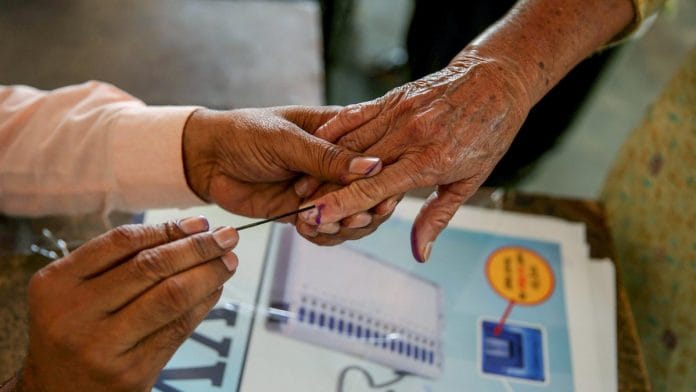Did the farmers’ anger bring the BJP down? Was it a subterranean anxiety of the Dalits? Did the EBC shift away from the BJP? Or was it the Muslim ‘vote-bank’? What happened to the BJP’s newly acquired women’s vote? These and similar questions have dominated the analysis of the recent electoral shock.
The 10 charts presented here try to answer these questions with the help of the most authoritative post-poll survey conducted by the Lokniti-CSDS team. We draw upon the reports they have published in The Hindu and the data publicly available in their archives that go back to 1996.
The evidence that we analyse below demolishes many myths. This election did not see any major shift in the voting preferences of major social groups at the national level. On the one hand, there was a small but critical shift among the Dalits, poor and landed peasant communities, especially in rural areas, while the Muslim vote was more consolidated. On the other hand, the BJP retained its core vote among the ‘upper’ caste, ‘middle class’ Hindus, and Extremely Backward Classes and added to its lead among the Adivasis. The net outcome was a small decline in votes for the NDA at the national level. The more interesting and impactful changes were at the state level.
The analysis presents us with a big political challenge. The BJP’s rise to power in the 1990s was accompanied by the creation of a ‘new social bloc’, a social coalition of the privileged — ‘upper’ caste, ‘middle’ class, urban and male voter — to which it stapled some non-privileged communities to manufacture a political majority. Modi’s rise to power consolidated this further by incorporating a significant part of the underclass — EBCs, poor and Adivasis — as subordinate and largely symbolic partners in its coalition.
While the BJP has faced a political defeat in this election, its social coalition is largely intact. The political task of uniting the bottom half of the social pyramid — poor, villagers, Dalits, Adivasis, OBCs and minorities — is still a long way off. The Social majority of India, the Bahujan, is still waiting to be converted into a political majority. That is the central challenge of the Congress party and its allies in the INDIA coalition.
Chart 1: Hindu ‘Upper’ Castes continue as BJP’s most loyal vote bank
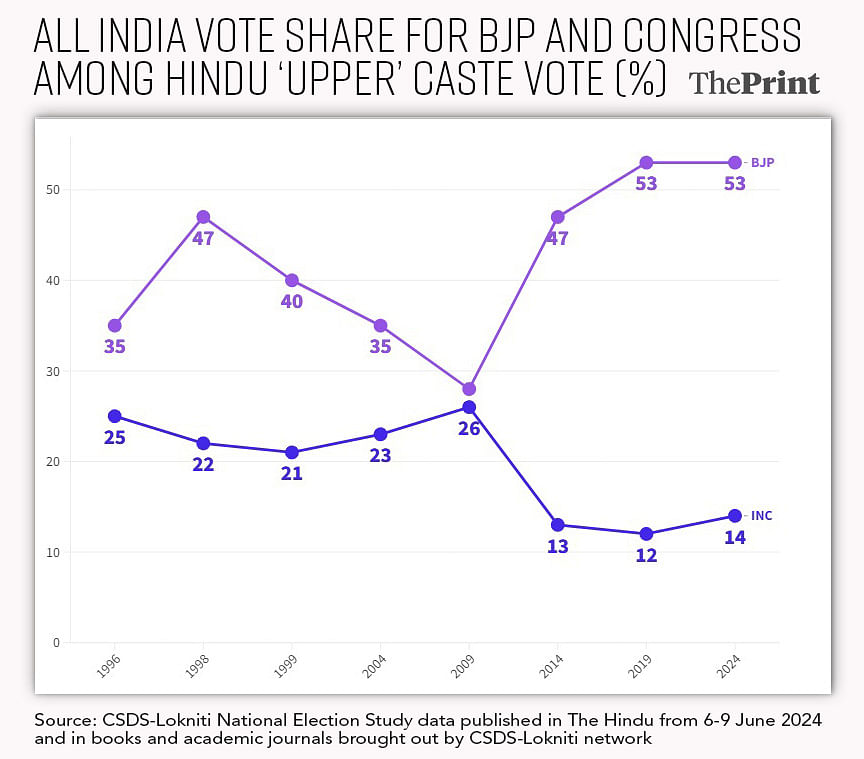
- Notwithstanding rumours to the contrary in every election (for example Rajputs’ unhappiness in Uttar Pradesh (UP), Kshatriyas’ rebellion in Gujarat), ‘Upper’ caste Hindus have remained the most loyal and invisible ‘vote bank’ for the Bharatiya Janata Party (BJP), and are bigger in size than the ‘Muslim vote bank’ of the Congress.
- Wherever there has been a generalised swing away from the BJP (for exampleHaryana and UP this time), the ‘upper’ caste voters have also shifted slightly.
Chart 2: Shift toward INDIA among select landed peasant communities
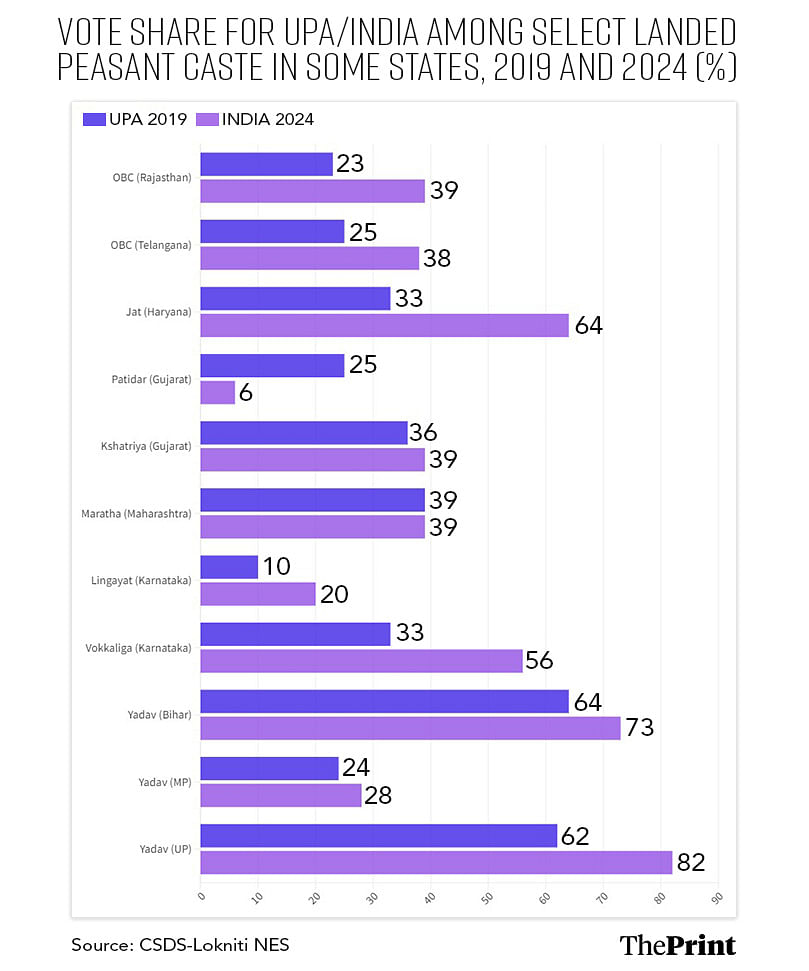
- The landed farming communities – non-Savarna, but not always Other Backward Classes (OBC)– that dominate rural India have shifted toward INDIA, away from BJP and allies, perhaps due to rural distress and the farmers’ agitation.
- This has impacted the outcome in many states: the moving away of Jats in Rajasthan and Haryana, Yadavs in UP, Marathas in Maharashtra and, to a lesser extent,Vokkaligas and Lingayats in Karnataka has hurt the NDA.
- Yet the BJP has held on toor improved its vote share in some of these communities in its strong state: for example, Patidars in Gujarat and Yadavs in Madhya Pradesh
Chart 3: NDA holds EBCs, despite critical losses in key states
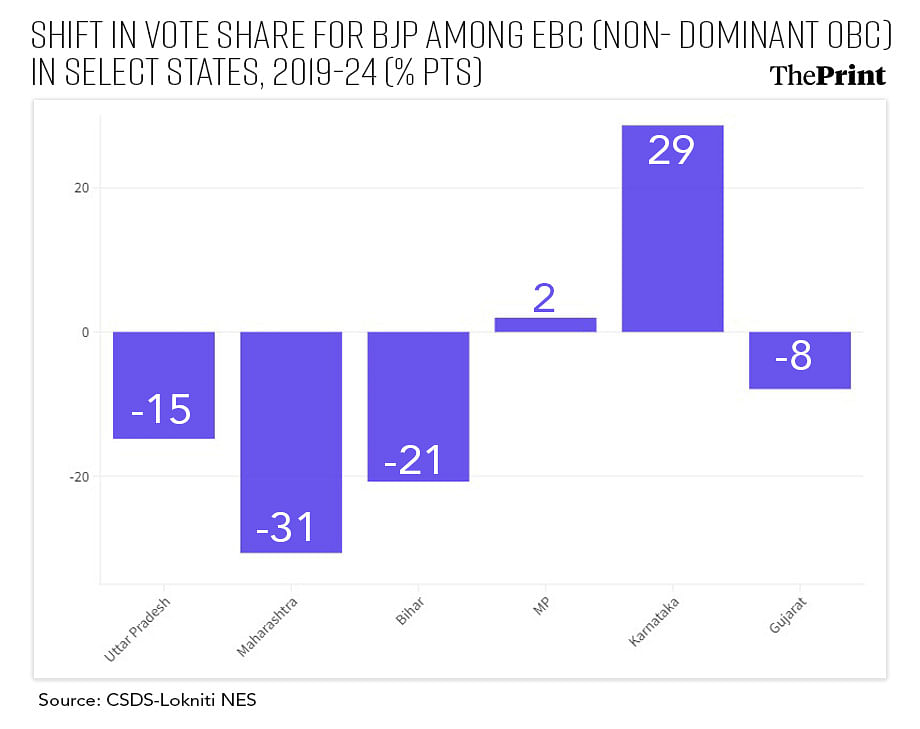
- The Extremely Backward Classes(known by different names but broadly comprising small service, artisanal and landless agrarian communities) have emerged as the BJP’s biggest base in rural India. Overall, their level of support has stayed at the same level for the BJP and its allies, but there is an important North-South divergence.
- In states like Haryana, UP and Bihar, EBCshave swung away significantly (10 percentage points or more) from the NDA. In Maharashtra, the BJP lost considerable vote share among non-Kunbi OBCs, a group that had been loyal to it for a generation.
- In the South, BJP has made substantial gains in Karnataka, Telangana and especially the large EBC Ezhava community in Kerala.
Chart 4: Dalit voters abandon BSP, move away from NDA and toward INDIA
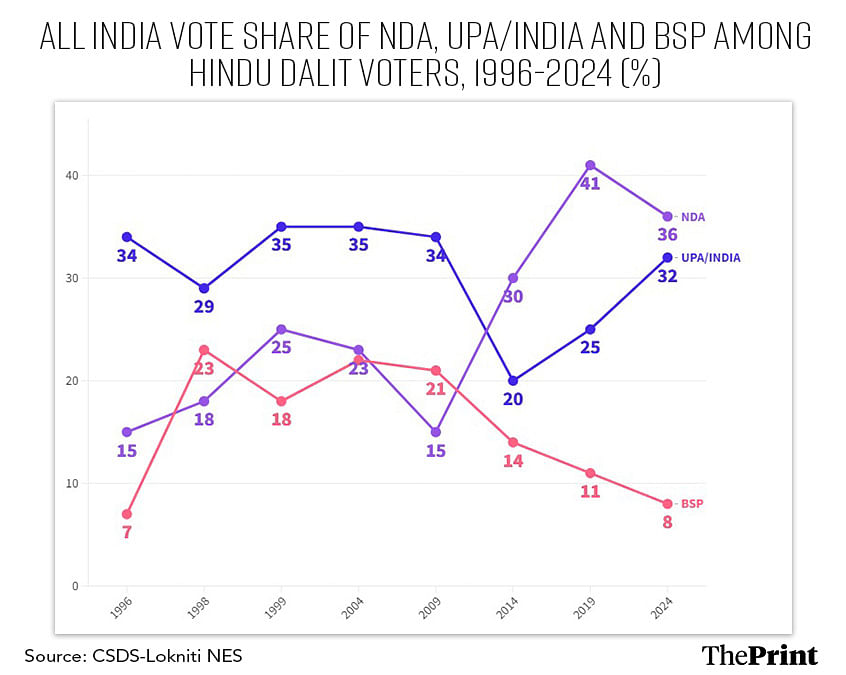
- Dalits have moved significantly away from their community-centric parties: the Bahujan Samaj Party (BSP) in UP and other parts of North India and the Vanchit Bahujan Aghadi (VBA)in Maharashtra. Less than half of Jatavs in UP and Buddhists in Maharashtra voted for the BSP and VBA respectively.
- Despite gaining from the collapse of the BSP and VBA, in overall terms,the BJP and its allies have suffered a significant 5 percentage points loss in the Dalit vote share. Non-Jatav SCs in UP, many Dalit groups in Bihar including Dusadhs/Paswans and a majority of all Dalits in Haryana have shifted from NDA to INDIA. However, the BJP has retained Dalit support in MP and Gujarat and made inroads into the Madiga community in Telangana.
- Congress and its allies, have made asteady comeback among Dalit voters overall, and are now almost at par with the NDA.
Chart 5: NDA adds to its massive lead among Hindu Adivasi voters
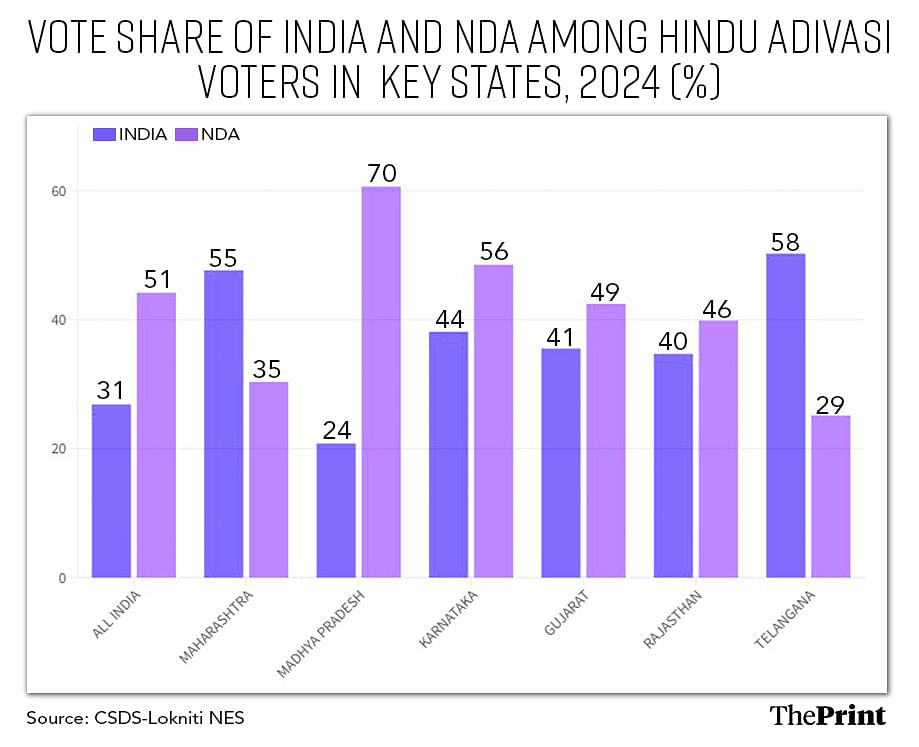
- This trend would worry Congress the most. Despite overall reversals, the BJP has continued its streak of consistent gains among the Adivasis from just under a quarter vote sharein 2009 to just under half in 2024. Congress trails BJP by 20 percentage points among Adivasi voters.
- Aproportion of the BJP’s gains have come at the cost of the Biju Janata Dal (BJD), Bharat Rashtra Samithi (BRS) and Trinamool Congress (TMC). But the Congress, too, has lost significant vote share among Hindu Adivasis in MP and Chhattisgarh.
Chart 6: Consolidation of Muslim votes to defeat the BJP
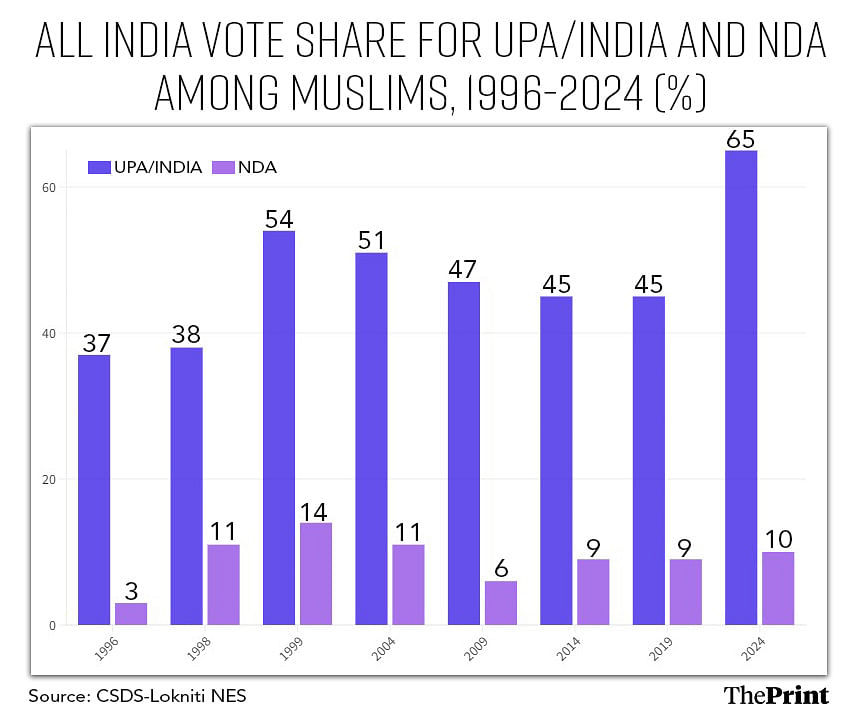
- The context of this election and the BJP’s relentless attack on Muslims led by the PM forced the former to come together in order to defeat the BJP.
- In parallel, many of the parties that are, in their own regions, the first choice for Muslims, came together under the Opposition INDIA bloc.
- Although Muslim turnout remained a little lower (62 per cent) than the national average (65 per cent), the Muslim vote for the dominant anti-BJP formation reached its highest at 65 per cent. This is even higher if you include the TMC votes in the INDIA bloc.
- While this proportion behind a single bloc is high, the steep risein the trend of Muslim votes for the UPA/INDIA bloc from 45 per cent in 2019 to 65 per cent in 2024 is deceptive. If one adjusts for alliances, this rise is a bit more than 5 pp. This is because parties like the Samajwadi Party (SP) and (Jammu & Kashmir National Conference) JKNC were not a part of the UPA/INDIA bloc in 2019 – INDIA Bloc 2024 is not a like-to-like comparison with UPA 2019.
- In Uttar Pradesh, the coming together of SP and Congress under the INDIA bloc has prevented thesplitting of Muslim votes and aided consolidation.
- Assam’s Muslims have moved away from a community-centric party: All India United Democratic Front(AIUDF) to the Congress. All India Majlis-e-Ittehadul Muslimeen (AIMIM)’s national vote share has stagnated at almost its 2019 levels. In West Bengal, the new community-centric All India Secular Front has caused a mild flutter by cutting votes in four seats but has not cost the TMC any of those seats.
- At 38 per cent, Congress is the largest beneficiary of Muslim votes. But the support from Muslims is no more than one-fourth of its overall vote share
- However, the BJP’s own tiny slice of Muslim votes has not dropped and remains fairly high (almost one-third) in Gujarat.
Chart 7: Small gains for Congress among the poorest, BJP stronger among the rich
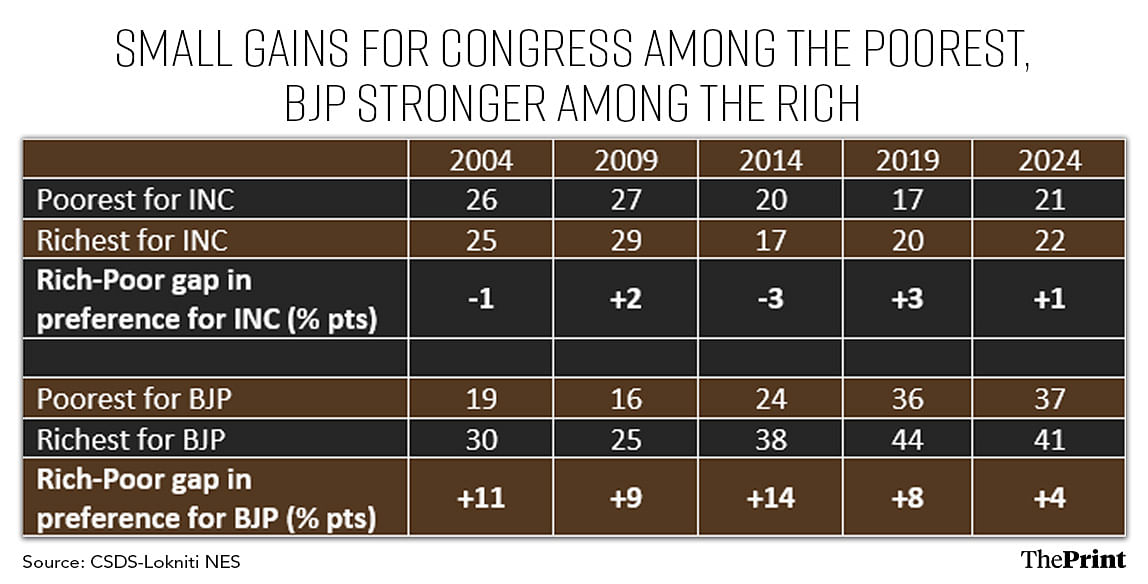
- While the BJP’s vote share has stagnated since 2019, there is no evidence as yet of sharp class cleavage in voting. Post-Modi BJP has filled up its deficit among the poor and the very poor voters, while it continues to do better among the better off.
- The Congress and its allies have gained votes among the poorest, reflecting thepartial success ofthe Congress campaign around pro-poor guarantees. But it has a long way to go to convert its policy position into a vote base.
Chart 8: BJP still lags among women voters
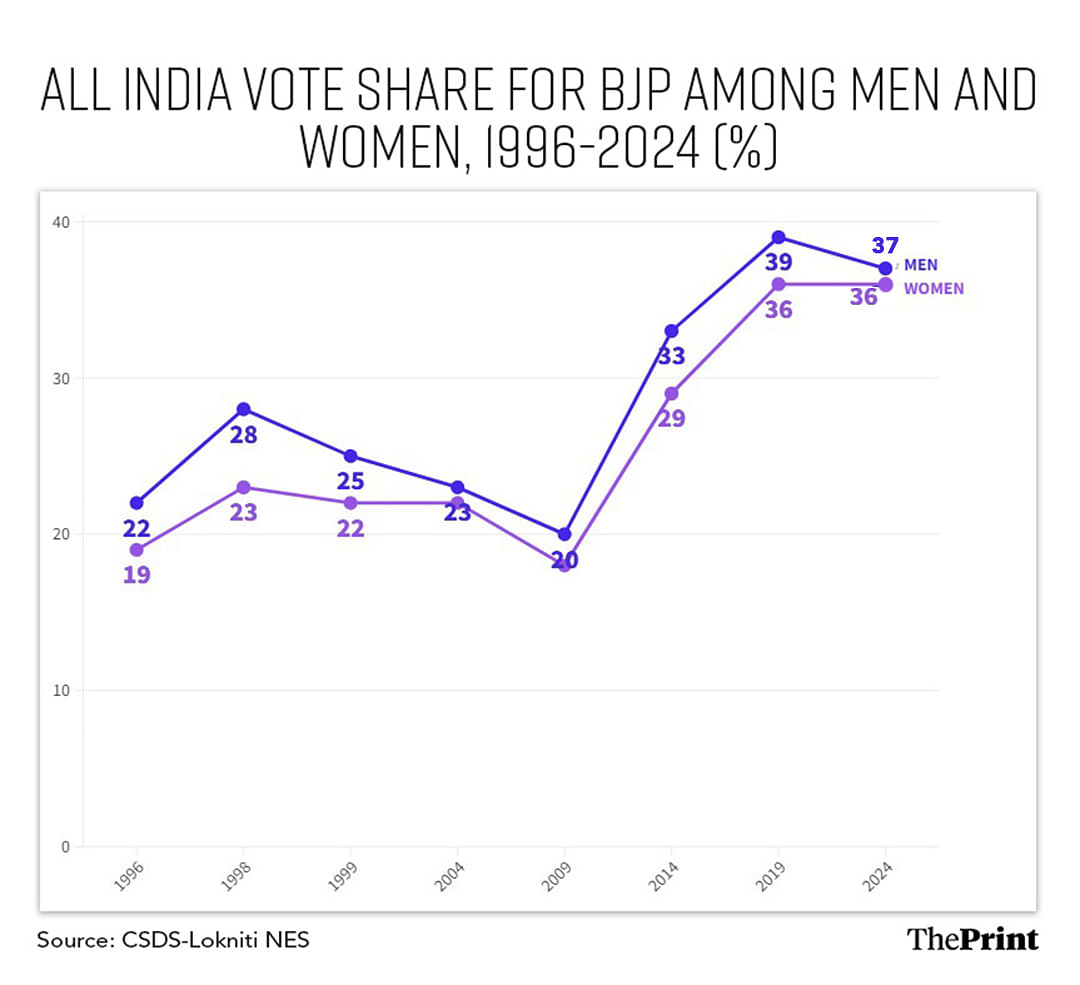
- This election continues the trend of higher turnout among women and greater attention to women voters by political parties. Yet, nationally, there is no evidence of a significant gap between the way men and women vote.
- While the BJP keeps advertising its schemes as women-centric, it continues to lag a bit among women.
- At the state level, gender differences do matter. In West Bengal, while the TMC vote share among men dropped a littleas compared to 2019, 10 percentage points more women preferred it to any other party in 2024. In Chhattisgarh, under a BJP state government, 3 pp more women have a preference for the BJP than men, which is attributed to a new cash-transfer scheme.
Chart 9: Gradual reduction in BJP’s youth advantage
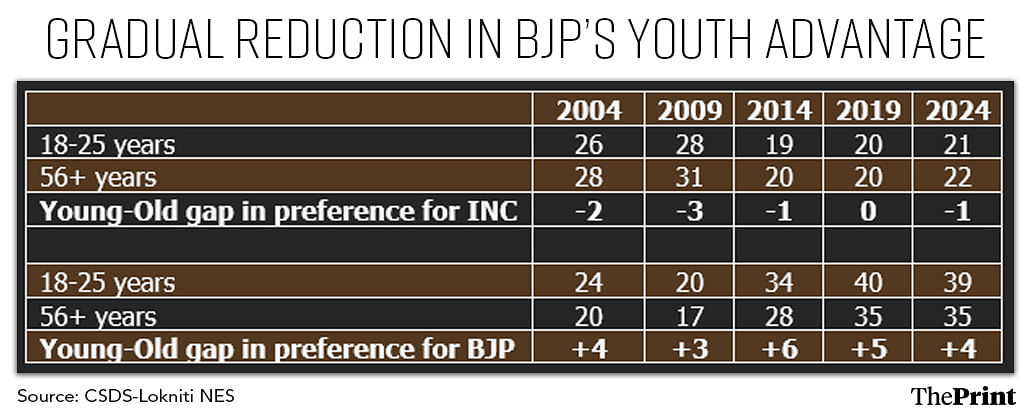
- India does not have the kind of age cleavage seen in European politics. There is a slight but notable drop of 1-2 percentage points in the young,below-35 age group’s votes for the BJP. This is notable because the BJP’s appeal in this demographic increased substantially in 2019 by a jump of more than 5 pp over 2014.
- There is little evidence to support the idea that the youth shifted to theINDIA Bloc: the margin of theNDA over INDIA of around 7 pp isalmost uniform across age groups: there is no visible youth preference for INDIA, even relatively.
Chart 10: NDA holds cities, INDIA gains in rural areas
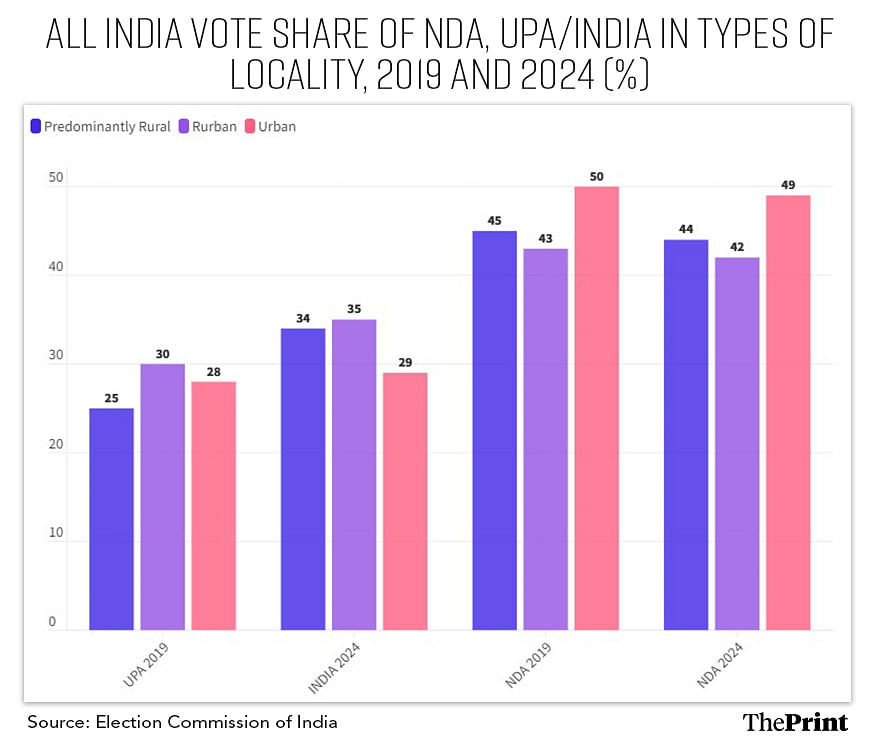
-
- The BJP maintained its dominance in cities and lost a bit of support in small towns and rural areas.
- Despite the strong showing of INDIA allies like the Shiv Sena (Uddhav Balasaheb Thackeray) in Mumbai and Dravida Munnetra Kazhagam (DMK) in Chennai, the increase in support for the INDIA bloc has been the least in cities. Their major gains are in rural and semi-urban constituencies.
Yogendra Yadav is National Convener of the Bharat Jodo Abhiyan. He tweets @_YogendraYadav. Shreyas Sardesai is a survey researcher associated with the Bharat Jodo Abhiyan. Rahul Shastri is a researcher. Views are personal.
The authors would like to reiterate that the data presented above has been sourced from the CSDS-Lokniti post poll article series published last week in The Hindu, as well as from various journal articles and book chapters authored by CSDS-Lokniti members and scholars over the years.
(Edited by Zoya Bhatti)



